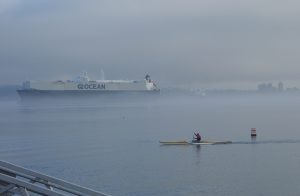Why are the sections of the fence around my garden (in Vancouver BC) made of BC cedar in Asia – i.e. the cedar was shipped twice across the Pacific? Cedar fencing is hardly a high-value product.
Ships encounter three forms of drag:
- Viscous drag from water sliding over the wetted part of the hull
- Wave drag from the energy pumped into the wake
- Aerodynamic drag on the superstructure
The first is handled in the usual way with a shape- and Re-dependent drag coefficient. Note that by convention the wetted area is used rather than the frontal (projected) area or wing area (for aircraft).
The second depends on a dimensionless quantity, the Froude Number $Fr$ which in turn depends on the ship’s length $l$, velocity $v$ and the acceleration due to gravity $g$ (Eqn.1)[note] Richard Fitzpatrick’s fluid mechanics pages, http://farside.ph.utexas.edu/teaching/336L/Fluidhtml/node151.html [2019-09-18].[/note]:
$\begin{equation} Fr = \dfrac{v}{\sqrt{gl}} \tag{1} \end{equation}$
The complicated way that the wave drag depends on $Fr$ is shown in Fig.1.

The wave drag D (shown on an arbitrary scale) depends critically on the Froude Number Fr.
It is generally hard for a ship to get past the big spike, which occurs when the waves from the bow and stern interfere constructively and large power is pumped into the wake. The velocity of peak drag is called the hull speed, vc = 0.56(gl)1/2 which determines how fast a ship can move. The bigger the boat, the faster it can go.
For example, the Maersk Triple-E 18,000-container vessels[note] Maersk Triple E-class container ship https://en.wikipedia.org/wiki/Maersk_Triple_E-class_container_ship [2019-09-18].[/note] are 400 m long and travel at 23 knots (11.8 m/s). Therefore the Froude number is 0.19, well below the speed where the wave drag spikes. The total power consumption is 60 MW, the cargo mass is 110,000 tonnes and the empty displacement 55,000 tonnes.
Some questions:
- What is the energy cost of transport EC for the Maersk Triple-E?
- According to Maersk, the fuel consumption of the Triple-E’s engines is 168 g/kWh (mechanical). What is the efficiency η of these engines? The enthalpy of diesel fuel is 45.6 MJ/kg.
- How much does it cost to transport a tonne of cargo, 10,000 km on the Triple-E?
Answers:
- Divide the power by the speed. EC = 0.046 MJ/tonne/km
- Convert g/kWh to MJ/kg and divide by the enthalpy of oil: η = 47% (about the practical limit for a diesel engine).
- Assuming $\$$1.50/L: $17 – why do you think nothing is made locally anymore?
